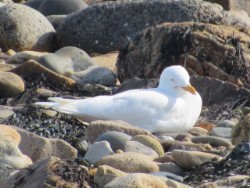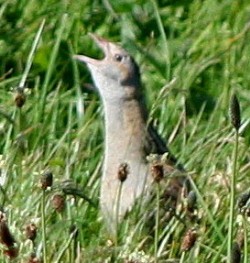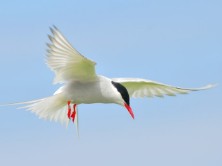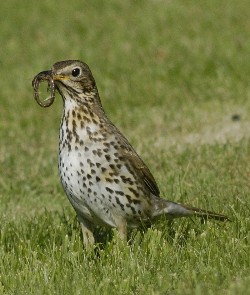May 2020
Bird Sightings



In terms of weather, the first half of May was very dry with the little rain that there was in the second half, including a storm around the weekend of 23 May. In comparison to last May, this May had a similar rainfall but was warmer, with a mean temperature 1.0 degree higher. The temperature range was large, from 24 degrees to negative 1.9 degrees. The lower range reflected the northerly wind direction this May with temperatures gradually rising after the storm. There was a feeling that while spring was arriving it was a little late. Conditions were generally good for birds trying to get on with breeding but Swallow and House Martin seemed to be delaying nesting perhaps because of the dry conditions. In addition, the storm with resulting high tides swamped the nests of a number of breeding shore birds round the coast.
It was a good month with over one hundred and ten species recorded, two of which had not been recorded on Arran for a number of years. Corncrake had not been recorded on the island for twelve years and this year there were reports from two areas. One called in a rashy field in Sannox throughout the first two weeks of the month. It was last heard on 13th. The other was heard in the Rodden area of the Shiskine Valley on 14th. In addition there was a report of a pair of Garganey on Sliddery Shore on 3rd. The only other record of this summer visitor on Arran was eight years ago in 2012.
Throughout the month the numbers of familiar summer visitors like Swallow, House Martin, Sand Martin, Willow Warbler, Whitethroat, Sedge Warbler and Cuckoo continued to build up. In addition to the "firsts" reported in the April notes, here are some further "firsts" with the 2019 arrival dates in brackets for comparison: Spotted Flycatcher in North Newton on 8th (11th), Wood Warbler in High Kildonan on 9th (17th), Arctic Tern on Silver Sands on 15th (14th) and two Swift over Sliddery on 30th (10th). To date there have been no reports this year of Lesser Whitethroat, Common Redstart, Nightjar or Common Tern.
Species who breed further north continued to pass through including; two Great Northern Diver in Whiting Bay on 1st, eleven Sandwich Tern at Drumadoon Point also on 1st, seven Whimbrel on Sliddery Shore on 3rd, three White Wagtail in Blackwaterfoot also on 3rd, ten Turnstone and twenty-six Dunlin on Blackwaterfoot shore on 11th, ten Sanderling at Drumadoon Point on 19th, one Bar-tailed Godwit at Cosyden on 24th and two Black-throated Diver in breeding plumage off Clauchlands on 27th.
In May, breeding was well underway for many species. Encouraging signs included reports of Golden Eagle, Golden Plover, Hen Harrier, Red-throated Diver and Short-eared Owl all holding breeding territories. Activity was reported from all the monitored heronries on the island and four areas held small numbers of breeding Lapwing. A number of coastal cliffs held single figure numbers of nesting Fulmar which seem to be in serious decline on Arran. I would be interested to receive any reports of young birds. None were reported in 2017, 2018 or 2019 from any colony. By contrast the Black Guillemot colonies seem to be thriving. Other breeding records included : ten Skylark singing in Doire Bhuide on 6th, two Woodcock roding over Machrie Moor on 15th, pair of Shelduck with nine young at Dhunan on 18th, pair of Mute Swan with six young at Machrie Bay on 26th and three pair of Common Sandpiper holding territories by the Fallen Rocks on 30th. In addition, towards the end of the month, there were lots of reports of garden birds carrying food and feeding recently fledged young, including young Goldfinch without the red face colour of the adult birds.
Here are some other highlights: a Little Grebe on Mossend Pond on 2nd, forty Gannet by the mouth of Loch Ranza on 16th, a leucistic Herring Gull in Blackwaterfoot on 18th,( This “white” Herring Gull was ringed on Arran in June 2018.) , three pair of Goosander on Sliddery Shore 19th, a Pale-breasted Brent Goose, an occasional winter visitor, on the shore at Silver Sands on 27th and three Moorhen on Mossend Pond on 30th.
Finally, there were a number of reports of a single Magpie in May. Magpie, a familiar bird on the mainland, is a vagrant on Arran with some years no records. The records could all have been the same bird ; Dippen Head on 2nd, Glenloig on 7th, Sannox on 26th, Marganaheglish on 28th and Sannox on 29th.
With the long daylight hours it is a great time of year to be birding. Most birds are getting on with the business of breeding. Please take a moment to report any signs of breeding birds to me, but please also remember that under the Nature Conservation (Scotland) Act 2004 it is an offence to intentionally or recklessly damage or destroy the nest of any wild bird while it is being built or used. Do not hesitate to report any criminal activity to the local police. Particularly take care on our shores and please keep dogs on their leads at this time of year.


